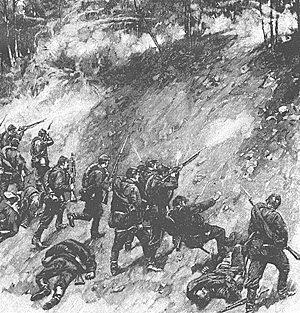 As the 19th century drew to a close, current military thinking still envisaged battles as being fought on a limited front with troops continuing to manoeuvre in the field, although increases in firepower and ranges caused this to be done at greater distances than before.
As the 19th century drew to a close, current military thinking still envisaged battles as being fought on a limited front with troops continuing to manoeuvre in the field, although increases in firepower and ranges caused this to be done at greater distances than before.
Aware that frontal attacks against steady infantry armed with modern weapons resulted in high casualties, it was accepted that troops should advance in more dispersed formations than of old and with greater caution; wherever possible frontal attacks should be replaced by flank assaults. Retaining the initiative was all important and the enterprising use of a cavalry screen to cover manoeuvres that might cut defenders off from their base indicated that static defence could easily result in defenders being forced to become attackers under highly disadvantageous conditions. In theory, attacks were to be supported by long range rifle fire and artillery, the latter was to remain on target until the attacking infantry approached their objective.
The British Drill book of 1874 recommended three line battalion attacks, led by two company skirmish (or firing) line extending in single rank, each rushing forward alternatively covered by the fire of the other. They were supported by two companies with the Reserve, under the Commanding officer, as the third wave, moving up in suitable formation. Supports were supposed to close up to the firing line when required with the idea of dominating the enemy at 200 yards range. When the charge took place, the Reserves were included if necessary, otherwise they might cover a flank, repels a local attack or cover the retreat if the attack failed.
Back to Table of Contents -- Wargamer's Newsletter # 171
To Wargamer's Newsletter List of Issues
To MagWeb Master Magazine List
© Copyright 1976 by Donald Featherstone.
This article appears in MagWeb (Magazine Web) on the Internet World Wide Web.
Other articles from military history and related magazines are available at http://www.magweb.com